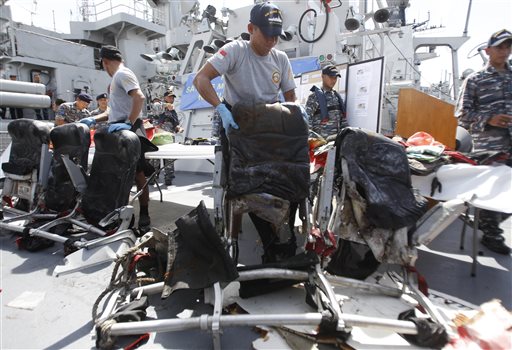JAKARTA, Indonesia — Searchers suspended efforts to reach the submerged body of the crashed AirAsia jet on Sunday because of poor visibility in the murky Java Sea.
One week after the airliner went down on its flight from Surabaya, Indonesia, to Singapore, recovery crews have located several large objects on the seafloor that are believed to be the fuselage of the Airbus A320-200. The flight ran into a thunderstorm, but the exact cause of the crash won’t be known until the flight recorders can be retrieved from the wreckage.
Earlier Sunday, officials sent 21 Indonesian navy divers equipped with cameras and sonar beacons into the water with the aim of reaching the largest object, which geological survey vessels had measured at about 60 feet long.
“But visibility on the seafloor was zero, and (the object) was covered with mud,” Bambang Soelistyo, head of Indonesia’s National Search and Rescue Agency, told reporters. “So the effort was suspended.”
Officials tried again to deploy a remotely operated underwater vehicle to pinpoint the wreckage in roughly 100-foot waters. But stormy weather wreaked havoc with the effort as it has for the past eight days, officials said.
“Weather remains a challenge, but there’s hope for tomorrow,” Bambang said at a news conference.
Four more bodies were found, bringing the confirmed death toll to 34, he said. A total of 162 mostly Indonesian passengers and crew were aboard, and all are presumed dead, many believed to be strapped into their seats in the body of the plane.
Indonesian Brig. Gen. Arthur Tampi, head of the national police medical department, said that as days passed, it was becoming more difficult to identify victims without DNA samples from families.
“The bodies are in a state of advanced decomposition,” Tampi said. “It’s impossible to identify them visually.”
Authorities in Surabaya have identified nine of the bodies, and experts from South Korea and Australia were due to arrive Monday to help identify the others, according to a statement from AirAsia.
Teams also found a fifth large object, about 32 feet long, lying close to the others, suggesting that the body of the aircraft could be relatively intact under water and did not break up during the thunderstorm.
More stray parts from the airline were recovered by crews, AirAsia said, including the emergency exit window, luggage and passenger seats.
Two U.S. Navy ships and two helicopters were participating in the recovery effort, which involves 27 vessels and 20 aircraft from at least seven countries.
Copy the Story LinkSend questions/comments to the editors.



Success. Please wait for the page to reload. If the page does not reload within 5 seconds, please refresh the page.
Enter your email and password to access comments.
Hi, to comment on stories you must . This profile is in addition to your subscription and website login.
Already have a commenting profile? .
Invalid username/password.
Please check your email to confirm and complete your registration.
Only subscribers are eligible to post comments. Please subscribe or login first for digital access. Here’s why.
Use the form below to reset your password. When you've submitted your account email, we will send an email with a reset code.